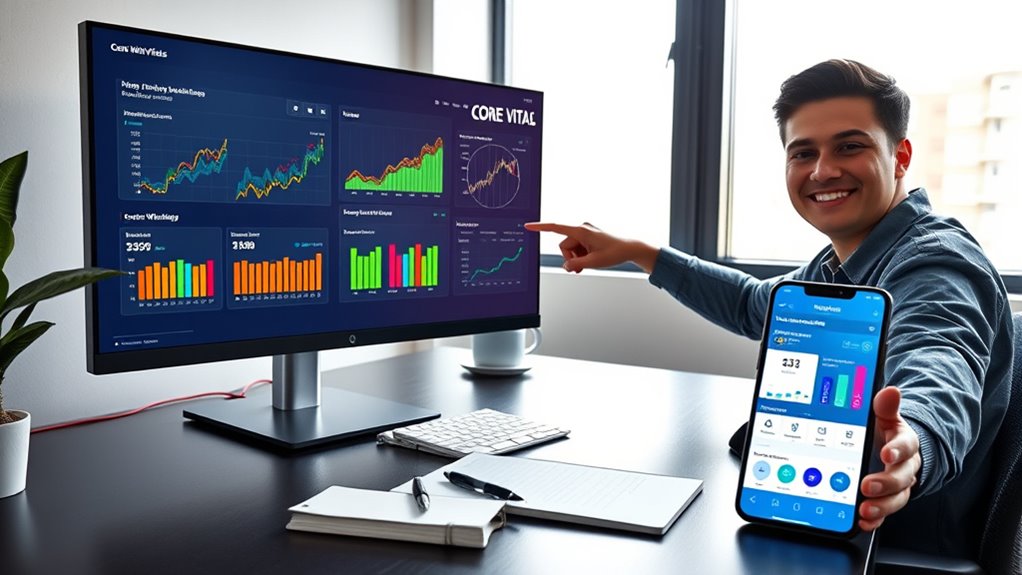Core Web Vitals are key metrics that help you understand how your website performs regarding speed, interactivity, and visual stability. By optimizing these areas, you can improve your site’s user experience, boost your search engine rankings, and keep visitors engaged. Focusing on fast load times, responsive interactions, and stable layouts reduces frustration and bounce rates. Want to get your website in top shape? Keep going to discover simple tips and strategies to master these essential metrics.
Key Takeaways
- Core Web Vitals measure user experience aspects like loading speed, interactivity, and visual stability to improve website performance.
- Optimizing loading performance involves compressing images, using modern formats, and minimizing heavy scripts.
- Enhancing interactivity requires reducing JavaScript execution time and breaking tasks into smaller segments for quicker response.
- Ensuring visual stability involves specifying size attributes and preventing dynamic content shifts during page load.
- Improving Core Web Vitals boosts search rankings, reduces bounce rates, and enhances overall user trust and satisfaction.

Are your website’s visitors sticking around or bouncing away? If they’re leaving quickly, it’s time to look into your Core Web Vitals. These are essential metrics Google uses to measure how users experience your site. They focus on three main areas: loading performance, interactivity, and visual stability. Improving these can boost your rankings and, more importantly, keep visitors engaged.
Struggling to keep visitors? Focus on Core Web Vitals to improve user experience and boost your rankings.
First, let’s talk about loading performance. You want your pages to load fast because nobody likes waiting. If your site is slow, visitors get frustrated and leave before they see your content. To improve this, optimize images by compressing them without losing quality, and use modern formats like WebP. Minimize the use of heavy scripts and remove unnecessary plugins, which can bog down your site. Implement caching so returning visitors load pages quicker. A fast-loading website keeps visitors engaged, reduces bounce rates, and signals to Google that your site offers a good user experience.
Next is interactivity, which is about how quickly your site responds when someone clicks a button or taps a link. If there’s a delay, users might think your site is broken or unresponsive. To enhance this, reduce JavaScript execution time and break up long tasks into smaller, manageable chunks. Use lazy loading for images and videos so they load only when needed, preventing your page from becoming sluggish. Ensuring your site responds promptly to user actions makes visitors feel confident and comfortable exploring your content, encouraging them to stay longer and explore more.
Lastly, visual stability pertains to how much your page shifts while loading. Imagine clicking a link and suddenly seeing text or images jump around—that’s a bad experience. To prevent this, specify size attributes for images and videos so the browser can allocate space in advance. Avoid inserting content dynamically without reserving space, as this causes layout shifts that frustrate users. A stable visual layout keeps the page predictable, reducing confusion and annoyance, which can help keep visitors engaged rather than abandoning the site.
Frequently Asked Questions
How Often Should I Check My Website’s Core Web Vitals?
You should check your website’s Core Web Vitals at least once a month to guarantee ideal performance. Regular monitoring helps you catch issues early and maintain a good user experience. Use tools like Google Search Console or PageSpeed Insights for quick insights. If you notice significant changes or updates, check more frequently. Staying proactive ensures your site remains fast, responsive, and user-friendly, boosting your search rankings and visitor satisfaction.
Do Core Web Vitals Affect My Website’s Search Engine Ranking?
If your website’s Core Web Vitals are poor, it can hurt your search rankings. For example, a small online store improved its LCP from 4 seconds to under 2 seconds, boosting its Google ranking and traffic. Search engines prioritize user experience, so fast, responsive sites rank higher. Regularly monitor your essentials and optimize page speed and interactivity to stay competitive and improve your visibility in search results.
Can Small Websites Improve Core Web Vitals Easily?
Yes, small websites can improve Core Web Vitals easily with simple steps. You can optimize images by compressing them, leverage browser caching, and minimize code to speed up load times. Fix any layout shifts and make certain your site is mobile-friendly. These small tweaks don’t require complex changes, making it manageable for you to enhance user experience and boost your search rankings effectively.
What Tools Are Best for Monitoring Core Web Vitals?
Think of monitoring Core Web Vitals like keeping a ship’s gauges in check. You’ll find Google’s PageSpeed Insights, Lighthouse, and Chrome DevTools are your reliable instruments. They offer real-time insights into your site’s performance, speed, and user experience. Google Search Console also acts like a seasoned captain, alerting you to issues. Use these tools regularly to navigate smoothly and guarantee your website remains healthy and fast.
How Long Does It Take to See Improvements After Optimizing?
You typically see improvements within a few days to a few weeks after optimizing your website. It depends on the changes you make—smaller tweaks might show results faster, while larger overhauls take more time to reflect in your Core Web Vitals scores. Keep monitoring regularly, and stay patient; consistent improvements will gradually boost your site’s performance and user experience.
Conclusion
Now that you understand Core Web Vitals, imagine your website as a well-oiled machine, ready to impress visitors at every turn. But the real question is—are you prepared to reveal hidden issues lurking beneath the surface? As you start optimizing, you’ll open faster load times, happier users, and higher rankings. The journey isn’t over yet—there’s more to discover that could transform your site forever. Are you ready to take the next step?









